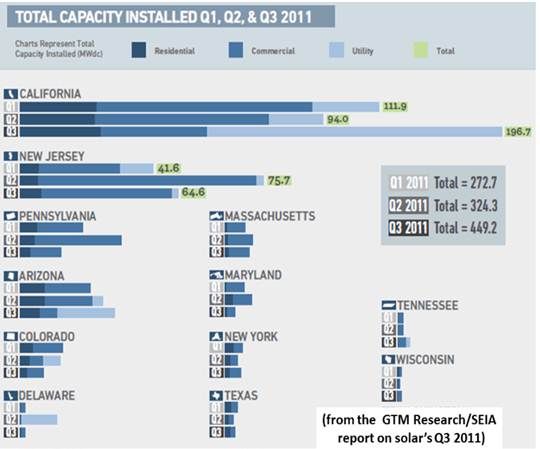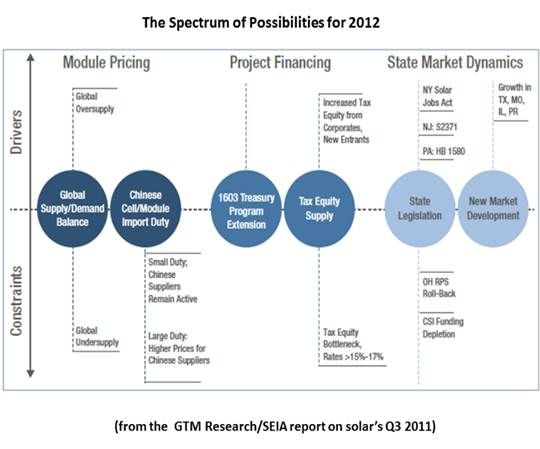With a mandate to obtain 33 percent of its power from renewables by 2020, a governor determined to meet that mandate, and an economy turning toward renewables for renewal, the real potential of California’s “solar gold rush” is no small question.
Author and director of the the New America Foundation’s Energy Policy Initiative Lisa Margonelli opened the Zocalo Public Square discussion by describing the dimensions of the gold rush. “We have about 2.5 gigawatts of solar approved,” she said. “We had about 225 megawatts in 2005-2006. We’ve scaled up by ten.” And, she added, “A gigawatt is essentially what a nuclear power plant produces.” Capacity factors differ, she noted, but “it’s clear we’re advancing toward some kind of tipping point” and “we’re about to find out what solar means.”
A show of hands requested by Director of U.C. Berkeley’s Renewable and Appropriate Energy Laboratory Dan Kammen demonstrated that the state’s many incentives and programs have not yet produced a high proportion of homeowners with rooftop solar, suggesting both obstacles and opportunities continue to persist.
But, Kammen said, there is a new solution. “What many people, including myself, think is the most exciting new policy innovation,” he said, “is the idea of feed-in tariffs championed in Europe. It’s giving a more diverse set of suppliers long-term contracts.”
He also described improved efficiencies and breakthroughs in financing. “It’s a huge new open world, especially in California, because we have great [solar resources],” he said. “We could grow by another factor of ten.” It is only a matter, he said, “of what we enable.”

SolarCity regional operating director Jim Cahill noted that even the Solyndra scandal was the result of “positive things that are happening with solar” like lower panel costs, lower installation prices and easier access to financing. The changes made Solyndra’s unique approach obsolete before it reached the market.
The so-called scandal didn’t impede solar growth, Cahill said. When he first started with SolarCity, the trendsetting company that is pioneering the no-upfront-cost, lease-financing solar system installation, “we had 20 guys working in Southern California. We now have 300.” And, he added, they have to be local jobs, because that’s where the installations have to happen.
Solar, Kammen said, provides four to five times as many jobs as natural gas and three times as many jobs as energy efficiency.
If there is an obstacle to the solar gold rush, Margonelli said, it is “complicated politics.” Inconsistent support at the federal level for the investment tax credit (ITC), the production tax credit (PTC), the cash grant provision and loan guarantees are like “asking for bankruptcies,” she said. Renewables advocates, she pointed out, cheered the fact that a trillion dollars has been invested in the sector since 2004, while forgetting that the U.S. has squandered a trillion dollars over the last 10 years in traffic jam costs.
Politics are challenging, agreed Los Angeles Department of Water and Power (LA DWP) General Manager Ron Nichols. Five to seven percent of the 33 percent of California’s power that will come from renewables by 2020 will come from solar, he said, and that will likely cost ratepayers a bill increase of 50 cents per month. But, he said, the present L.A. City Council won’t accept an increase of just 10 cents a month.

Nevertheless, he said, “We are going to replace 80 percent of our power supply in the next 10 years as the result of thousands and thousands of different individual actions.”
The solar gold rush, Kammen said, “will only fail if we don’t take advantage of the opportunity,” but, he continued, “there is no question we can make the gold rush work” if the frame of reference changes. “We’re still operating really well in the startup mode -- still doing it as a cottage industry.”
Solar on the roof, Kammen said, should not be an after-market retrofit. “If you don't do it, you should have to file a petition and get a permit.” Solar should be assumed. “When it becomes a part of the building process and you have to get a variance not to do it, the price can drop dramatically.” But to reach that point, Kammen added, “the commitment has to be there.”
Nichols, who has wrestled with staunch, tight-fisted politicians to expand the DWP’s renewables programs, made one final point. “We want to build solar so that it is not a gold rush that comes, booms, and fades. Are we doing it fast enough? I hear every day that no, we’re not.” But, he concluded, “We want to do it in a way that grows it and allows it to become a ubiquitous part of our power supply.”
After the panel discussion, Margonelli told a story about two recent blackouts. When the power went out a few years ago, she said, she had no battery-powered capabilities and spent the duration of the outage sitting in the dark with a candle. In a more recent outage, she had a solar-panel-powered, battery-charged lamp, and batteries in her computer and phone with charge remaining. “I pretty much just continued on as usual until the electricity came back on,” Margonelli said.
These leaders seem to agree that California’s solar gold rush is only seen to be failing by those who fail to appreciate the value of incremental change and cannot imagine its cumulative transformative capability.



